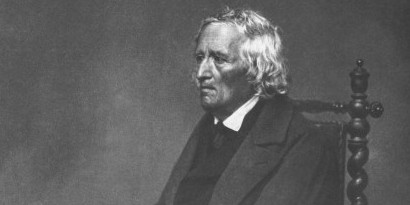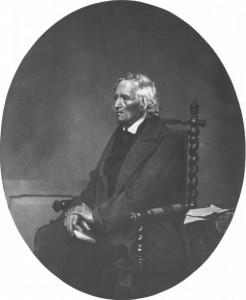Jacob Grimm 1845
Jacob Grimm (1785–1863) was one of the Grimm brothers who are best known for their fairy tale collections. Grimm worked as a professor of German philology and the lecture that he gave at the Berlin Academy on March 13, 1845, on the topic ”Ueber das finnische Epos” (”About the Finnish epic”) made the Kalevala widely known among researchers in Central Europe. The lecture was published the same year as a 43 page article in the magazine Zeitschrift für die Wissenschaft der Sprache, by A. Höfer.
The Kalevala lecture by Grimm was primarily about the first edition of the Kalevala by Lönnrot, which was a two-part book. Mathias Alexander Castrén’s “excellent Swedish translation” (1841) was of great help to Grimm when he wrote the lecture.
Grimm approached the Kalevala from three viewpoints, a linguistic, a mythological and an aesthetic viewpoint. Linguistic and mythology research is comparative research, whereas research from an aesthetic viewpoint gives as us an idea of the impression that Grimm had of the Kalevala and also of the socio-historical context in which Grimm placed the epic. The repetitions in the poems of the Kalevala were, according to him, “an excellent proof of the natural variations and the diligent annotations of them. Here, if anywhere, the pure epic flows in its most simple form, but on the other hand, in its most powerful form that we have not heard before, but the richness of the myths, images and expressions, that relate to what we already know [myths, images and expressions].” (Grimm 1845, 79.) Grimm emphasises, in particular, the “vivid and vulnerable feeling of nature” in the poems, something that you can experience almost nowhere else than in Indian poetry. The work by Lönnrot can be compared to the national narrative poetry compiled by the Serbian, Vuk Karadžić. The coming generations will not forget the names of these two men. He compared the Finnis epic and the Serbian compilation to the Poems of Ossian (Ossianin lauluihin) when he said:
“The value of these impeccable compilations is so much higher than the much scolded Poems of Ossian, published by Macpherson for the first time about eighty years ago, which totally lack an epic character. The Finnish epic contains much that, in turn, make our own German ancient history more clear, whereas there is nothing in the emotional Poems of Ossian. This is the most distinct proof of the superiority of the former compared to the latter.” (Grimm 1845, 79)
Grimm gave an extensive explanation of the Finnish language and mythology in his lecture. However, the most important part was the description of the contents of the Kalevala and several verses from the Kalevala were added to the description. The most notable of these is the German translation of the 19th poem and the verses 206–244, which is done based on Castrén’s Swedish translation. Grimm also added a Finnish version to this (Grimm 1845, 106–107).
It has to be noted that Grimm’s translation, by no means, was the first German translation of a single poem or part of a poem in the Kalevala. Nevertheless, his lecture was significant, perhaps even crucial, in the sense that it connected the Kalevala with the general theoretical discourse about norms that are set for epic tales, about the nature and the creation of an epic tale. Grimm also pointed out the importance of the Kalevala for the national development of the country of Finland and, thus, gave it a both social and political framework.
There are a lot of references to this lecture in later scientific and popular journals, since it put, without any questioning, the Kalevala on the same level as the Song of the Nibelungs, the Poems of Ossian, Serbian folk poetry and the epics of the antiquity. The Kalevala became the object of both scientific and ideological as well as historical discourse and also a norm to which other epic tales could be compared. This aspect of comparison was emphasised even more when different translations of the Kalevala came out.
Also read the thank you note from Elias Lönnrot to Jacob Grimm (dated on October 4, 1845).
Liisa Voßshcmidt: ”Saksan kautta eurooppalaiselle kulttuuriareenalle” – Kalevala maailmalla. Helsinki: SKS. 2012.

